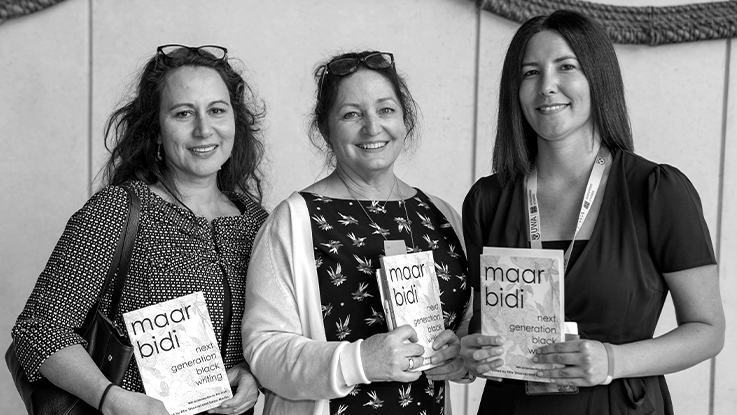
maar bidi editors Rachel Bin Salleh, Elfie Shiosaki and Linda Martin. Image courtesy of UWA.
I’m weary of waiting
I’m told by others to be the best version of myself
but how can I, when I don’t know my full self
–Serena-May Brown, ‘Navigating home’1
Academia has inherited a long history of non-Indigenous people speaking for Indigenous people and defining Indigeneity and Indigenous cultural heritage – each recurring act erasing Indigenous voices and agencies to speak. Within the discipline of Indigenous Studies, scholars are carving out new transformative pedagogical spaces to create Indigenous-determined stories and storylines. We advocate that, now more than ever, next-generation Indigenous storytelling is needed to nurture intergenerational story cycles which imagine and enliven Indigenous-determined futures.
We gather at Bilya Marlee on Whadjuk Noongar boodja, where Kaart Geenunginyup Bo (the place from where you can look afar) meets the beeliar.2 We acknowledge the Whadjuk people of the Noongar Nation, their ancestors and Elders, and Whadjuk story cycles held in the land-, water- and skyscapes on boodja. We thank Whadjuk Traditional Owner Len Collard for creating the Noongar language phrase maar bidi for our collaboration. Maar bidi means to carve out a pathway with your hands. It can be translated as handwriting.
Plains Cree and Saulteaux woman Margaret Kovach teaches us that ‘we know what we know from where we stand’.3 Our knowledge is grounded in our own standpoint, and sense of place and belonging to place. We acknowledge our diverse standpoints on Whadjuk boodja. Elfie Shiosaki is a Noongar and Yaruwu writer. She is Lecturer in Indigenous Rights at the School of Indigenous Studies (SIS), and Editor of Indigenous Writing at Westerly. Linda Martin is a non-Indigenous lecturer in creative writing at SIS, an editor, and co-publisher of Night Parrot Press. Nadia Rhook is a non-Indigenous lecturer in history at SIS, and a published poet.
- Extract from ‘The Signs’ by Serena-May Brown, in maar bidi: next generation black writing (Shiosaki and Martin 2020, p. 13). Reproduced with the author’s permission. ↩
- The Bilya Marlee (River of Swan) is an Indigenous-centered space at the School of Indigenous Studies (SIS) at the University of Western Australia (UWA). This space is conceptualised as a marlee marlnyinup (swan nest) to grow and nurture next-generation Indigenous scholars. ↩
- Kovach, M E 2009, Indigenous methodologies: Characteristics, conversations, and contexts, University of Toronto Press, Toronto, p. 7. ↩













